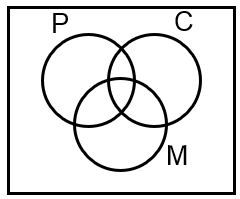In a class of 140 students numbered 1 to 140, all even numbered students opted Mathematics course, those whose number is divisible by 3 opted Physics course and those whose number is divisible by 5 opted Chemistry course. Then the number of students who did not opt for any of the three courses is

= 144 – 9 – 14 – 23 + 4 = 102
So required number of student = 140 – 102 = 38
This problem involves finding the number of students who did not opt for any of three courses (Mathematics, Physics, Chemistry) in a class of 140 students, based on their roll numbers. We'll use the principle of inclusion-exclusion to solve it.
Step 1: Define the Sets
Let:
Step 2: Find the Number of Students in Each Set
Number of students in M: Even numbers from 1 to 140. There are 140/2 = 70 students.
Number of students in P: Numbers divisible by 3. The largest multiple ≤140 is 138 = 3×46, so there are 46 students.
Number of students in C: Numbers divisible by 5. The largest multiple ≤140 is 140 = 5×28, so there are 28 students.
Step 3: Find Pairwise Intersections
Students in M and P: Numbers divisible by LCM(2,3)=6. Largest multiple ≤140 is 138=6×23, so 23 students.
Students in M and C: Numbers divisible by LCM(2,5)=10. Largest multiple ≤140 is 140=10×14, so 14 students.
Students in P and C: Numbers divisible by LCM(3,5)=15. Largest multiple ≤140 is 135=15×9, so 9 students.
Step 4: Find the Triple Intersection
Students in all three sets: Numbers divisible by LCM(2,3,5)=30. Largest multiple ≤140 is 120=30×4, so 4 students.
Step 5: Apply Inclusion-Exclusion Principle
Number of students who opted for at least one course:
Step 6: Find Students Who Opted for None
Total students = 140
Students who opted for at least one course = 102
Students who did not opt for any course = Total - (At least one) = 140 - 102 = 38
Final Answer: 38
Inclusion-Exclusion Principle: For three sets A, B, and C, the number of elements in their union is given by:
Least Common Multiple (LCM): The smallest positive integer that is divisible by each of the given integers. Used to find numbers divisible by multiple conditions.
Floor Function (⌊x⌋): Gives the greatest integer less than or equal to x. Used to count multiples up to a number N: count = ⌊N / divisor⌋.